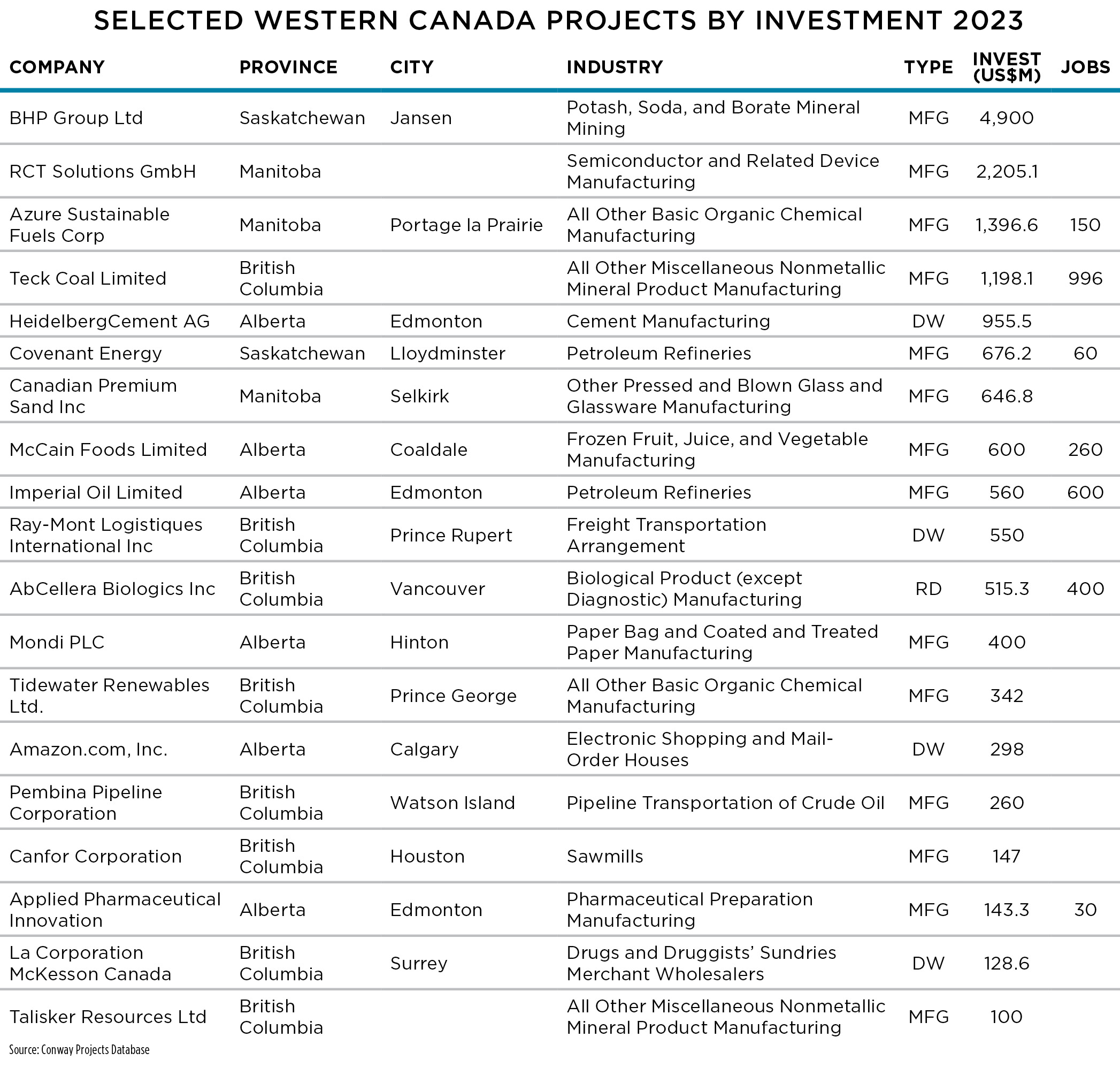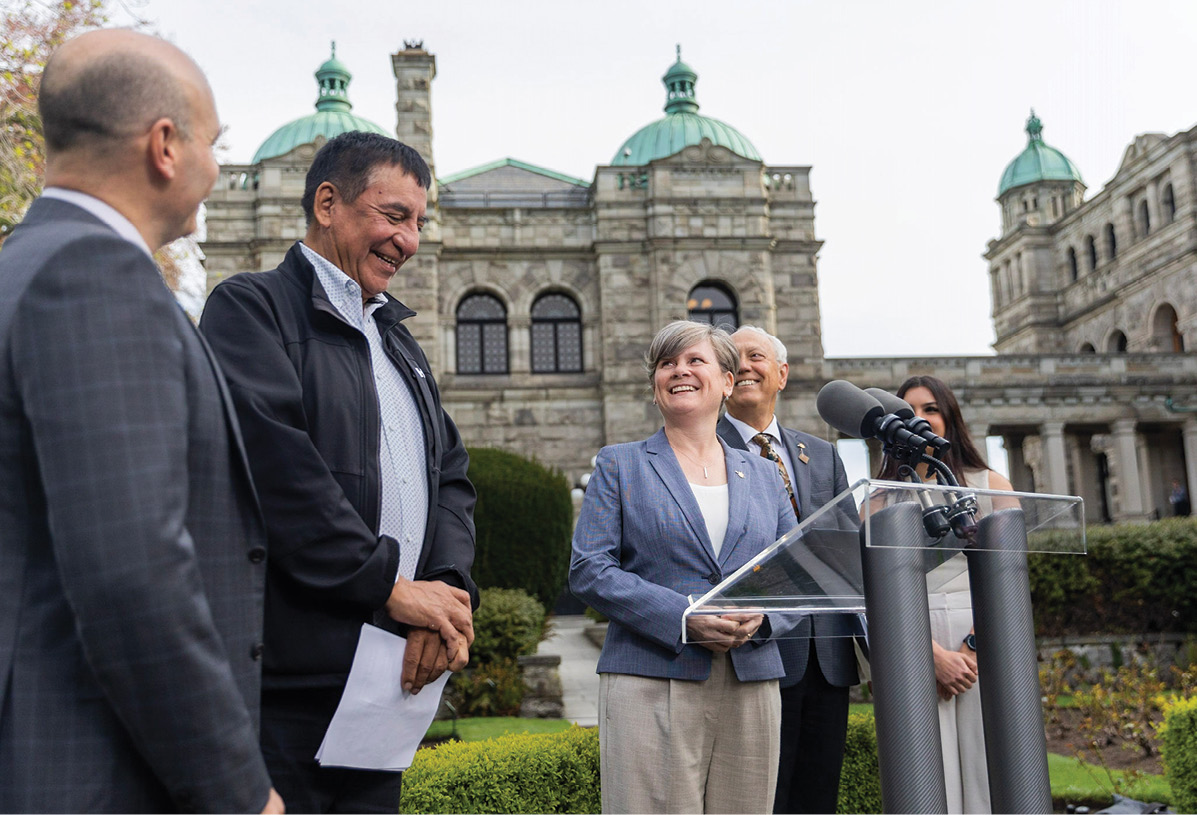When the Klondike gold rush descended on the Peace River region of British Columbia in 1898, some 500 Beaver and Tse’Khene peoples refused passage through their territories, says a history of the McLeod Lake Band of the Tse’Khene people, known as the “People of the Rocks” for their proximity to the Rocky Mountains. Like its neighbors to the south, the Canadian government proposed a treaty, Treaty 8, but because of the province’s unwillingness to transfer land, failed to sign the McLeod Lake Indian Band (MLIB) to that treaty for more than 100 years.
“The Treaty Adhesion Settlement provided the Band with an undisclosed amount of dollars that are held in trust and some 20,000 hectares [49,420 acres] of forest lands, Indian Reserve lands, and fee simple lands,” explains the history of the Band, whose membership numbers approximately 515, 300 of whom live in different parts of B.C.
In May 2023, the provincial government and MLIB reached new revenue-sharing and other agreements “to guide joint work on assessing and managing the impacts of industrial development and creating a shared path forward for healing and restoring the land, while providing certainty to industry partners working with Nations in their territories,” said a government release. They also have set the stage for a megaproject for the ages.
“These agreements prioritize sustainability, fair distribution of benefits and Treaty Rights,” said MLIB Chief Harley Chingee. “Not only will they benefit our present members, but they also ensure that future generations will inherit more prosperous and healthy land.”
In January 2023, B.C. and four other Treaty 8 Nations signed similar agreements following a June 2021 B.C. Supreme Court ruling that determined that “the constitutionally protected Treaty 8 rights of the Blueberry River First Nations were breached by the cumulative impacts of industrial development authorized by successive provincial governments over many years,” said the province.
All of which paved the way for an industrial development with multi-generational impact, as MLIB and the province in October signed an MOU that “lays the foundation for a proposed Tse’khene energy transition hub (TETH), supporting economic reconciliation and development for the region through the production of low-carbon energy,” the province said. The first proposed project is a hydrogen production facility that would help to significantly reduce emissions in industries that are hard to decarbonize. The province has pledged to reduce such emissions by 40% by 2030.
The second proposed project is a straddle plant that would also reduce carbon emissions by extracting high-value natural-gas liquids that would otherwise be burned as by-products in the gas distribution system. “Collectively, the projects are worth approximately [C]$7 billion and could create as many as 2,000 construction jobs and 500 permanent, full-time jobs.”

The hub would be located north of Prince George on the Kerry Lake East Indian Reserve. The MLIB has worked to develop the Tse’khene energy transition hub into a viable project “and has secured several world-class industry partners that are pursuing definitive agreements in order to further advance multiple on-reserve projects,” said the province.
“The MLIB values its partnership and collaboration with the Province and the BC Energy Regulator as it advances the development of billions of dollars of on-reserve clean energy infrastructure,” said Chief Chingee. “My message to our band members is that we have been working hard to develop an environmentally and culturally responsible opportunity that, if successful, will make us a key contributor to a clean-energy future while also delivering much-deserved prosperity to our band and its members. My message to industry is that the MLIB is a commercially sophisticated and enthusiastic potential partner.”
Asked for comment, a spokesperson for MILB says, “TETH aims to be built on MLIB reserve land, but they are open to interest from other Nations. MLIB has a ways to go before final approvals and the start of construction but they believe there will be job opportunities for MLIB members and others. As well, carbon creates the foundation for exciting economic projects that will provide direct benefits to the region and help lower emissions.”

Photo courtesy of Province of B.C.
In other hydrogen news, with C$16.5 million in funding from the province for the pilot, B.C.-based hydrogen-energy company HTEC announced in November it will procure six different heavy-duty fuel-cell trucks and complete upgrades to a hydrogen-fueling station in Tsawwassen and a maintenance facility in Abbotsford. The B.C. Pilot Hydrogen Truck Project aims to start the use of hydrogen in the commercial transportation sector. Within a week, HTEC signed an MOU with global green energy, metals, and technology company Fortescue to develop offtake opportunities for green hydrogen in connection to an export facility in Prince George.
At the bottom of HTEC’s home web page — like those of many Canadian companies on board with the national reconciliation processs with First Nations — appears a statement that the company “respectfully acknowledges that its head office operates on the traditional, ancestral and unceded territory of the Skwxwú7mesh (Squamish), xwmkwým (Musqueam) and slilwtał (Tsleil-Waututh) Nations.”
In 2021, B.C. became the first province in Canada to release a comprehensive hydrogen strategy. According to the province, more than 50% of Canada’s hydrogen and fuel-cell companies are in B.C., and the province accounts for nearly 60% of research investment in hydrogen and fuel-cell development.
Cedar LNG Reaches New Threshold
That agreement followed progress on another long-developing First Nations megaproject in B.C. as the province, after a multi-year assessment process, issued an Environmental Assessment certificate for Cedar LNG to construct and operate a floating liquefied natural gas (LNG) facility and marine export terminal located on Haisla-Nation-owned land on Douglas Channel in Kitimat. Haisla Nation is working with Pembina Pipeline.
“The Cedar LNG project will be the first Indigenous-majority-owned LNG export facility in Canada, providing an unprecedented opportunity for both Haisla Nation and the region,” said British Columbia Premier David Eby. “This is a significant milestone that honors our government’s commitment to respect self-determination and the Declaration on the Rights of Indigenous Peoples.”
Cedar LNG will be the largest First Nations majority-owned infrastructure project in Canada and play a key role in the Haisla’s economic development over the next four decades, creating opportunities for communities throughout northern B.C., said the province. “The project will receive natural gas from northeastern B.C. through the Coastal GasLink project and be powered by renewable electricity by connecting to BC Hydro’s grid, making it one of the lowest-emitting facilities of its kind in the world. It has an anticipated cost of US$2.4 billion, with an expected export capacity of three million tonnes a year. Up to 500 people would be employed at Cedar LNG during construction and approximately 100 people would be employed full-time when operational.”
“Powered by renewable electricity and with plans to achieve near-zero emissions by 2030, Cedar LNG showcases what responsible resource development can look like as we transition to a clean-energy future,” said B.C. Minister of Energy, Mines and Low-Carbon Innovation Josie Osborne.
Charging the Economy
Two battery supply chain projects have landed in Western Canada in recent months. In November, Taiwan-based E-One Moli announced plans to invest C$1 billion and create up to 350 new jobs while securing 100 positions at a new lithium-ion battery cell manufacturing plant in Maple Ridge, B.C., an eastern suburb of Vancouver located along the Fraser River. As part of the federal government’s strategy on securing key battery manufacturing facilities, the Government of Canada will contribute up to $204.5 million to support the project, through the Strategic Innovation Fund’s Net Zero Accelerator Initiative. The Government of British Columbia will contribute $80 million to the construction of the facility. Among the other partners united to support the project were Invest in Canada, Innovation, Science and Economic Development Canada (ISED), the Canadian Trade Office in Taipei, Taiwan, the B.C. government, the City of Maple Ridge, the City of Surrey and Invest Vancouver

Photo courtesy of Cedar LNG
Cells made at the facility will be used to electrify devices that have traditionally relied on diesel, including consumer electronics, power tools, medical devices, high-performance vehicles and aerospace applications. The facility is expected to be operational in 2028. That’s slightly slower than the two years it took for a new $350 million gigafactory to begin mass producing product in Q3 2023 in Kaohsiung, Taiwan. But it’s just the latest of several major battery investments in the country, nearly all of them until now in Ontario and Quebec.
“Canada is becoming a global leader in battery manufacturing thanks to all our advantages — access to global markets, a highly talented workforce, and all the critical mineral resources necessary to make batteries — and world-leading companies want in,” said Canada’s Minister of Innovation, Science and Industry François-Philippe Champagne in a release.
In Calgary, Alberta, the battery supply chain will be boosted by newly launched production of nanomaterials at Litus, formed in 2019 around research originally conducted at the University of Calgary. “Litus LiNC is an environmental, one-step solution that selectively harvests lithium from aqueous sources, and delivers unmatched results on low-concentration brines, making it both effective and economical, and able to uncover lithium from North American sources previously deemed uneconomical,” says the company.
BHP Moves Forward in Saskatchewan
Recovery of resources is central to a megaproject still unfolding in Jansen, Saskatchewan, from Australia-based resources giant BHP.
The company has approved an investment of US$4.9 billion (C$6.4 billion) for stage two of the Jansen potash project, following approval of US$5.7 billion (C$7.5 billion) for stage one of the project in August 2021 and a pre-Jansen Stage 1 investment of US$4.5 billion (C$4.9 billion). Jansen Stage 1 is 32% complete and progressing on schedule, with first production expected to be delivered in late 2026. Construction of Jansen Stage 2 is anticipated to take approximately six years, and is expected to deliver first production in FY2029, followed by a ramp-up period of three years.
BHP says the stage two investment “advances BHP’s strategy to increase its exposure to commodities positively leveraged to the global megatrends of population growth, urbanization, rising living standards and decarbonization. Potash, used in fertilizers, will be essential for food security and more sustainable farming.”
Westshore Terminals in Delta, B.C., is BHP’s main port facility to ship potash from Jansen to customers. The Jansen Stage 2 investment includes funding to increase storage facilities at the port.
The project will transform Jansen into one of the world’s largest potash mines, doubling production capacity to approximately 8.5 million tonnes per annum. “We are advancing our sustainability and economic development priorities for Jansen and we are pleased with the progress of our ongoing work with the Governments of Canada and Saskatchewan, as well as local and Indigenous communities on shared solutions,” said BHP CEO Mike Henry.
For both the sustainability and Indigenous engagement work, BHP and others might be looking to a McLeod Lake Indian Band saying for guidance: Wu’tun’e wee’zooh yi’yalh, whes’keghe s’o ududeh’chi oo’s’o ghu’nuyelh’o.
“Making sure the footprints we leave behind are the ones our children will be proud to walk in.”

